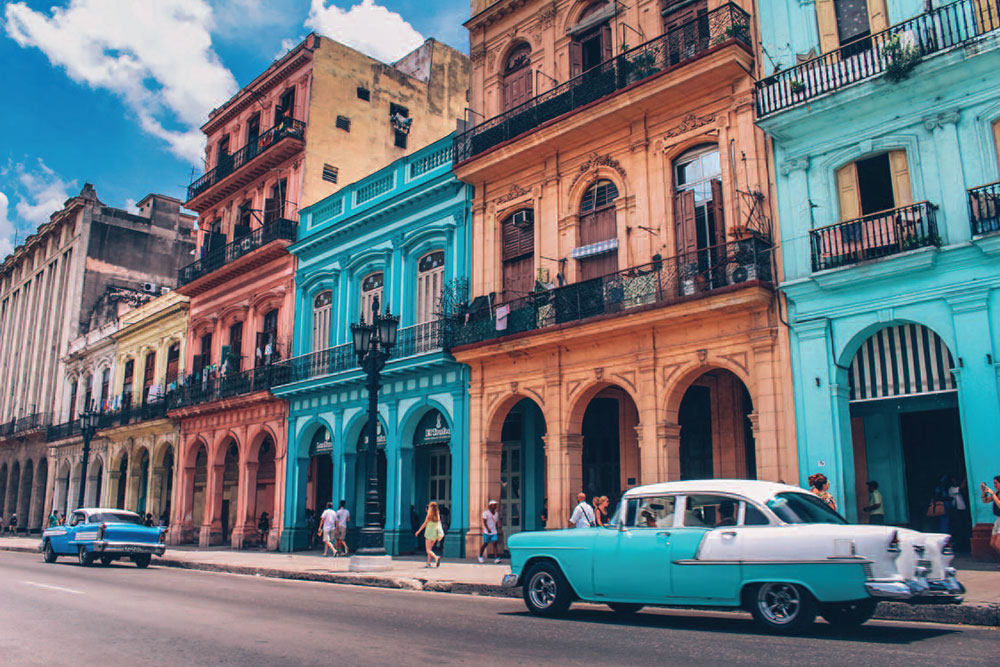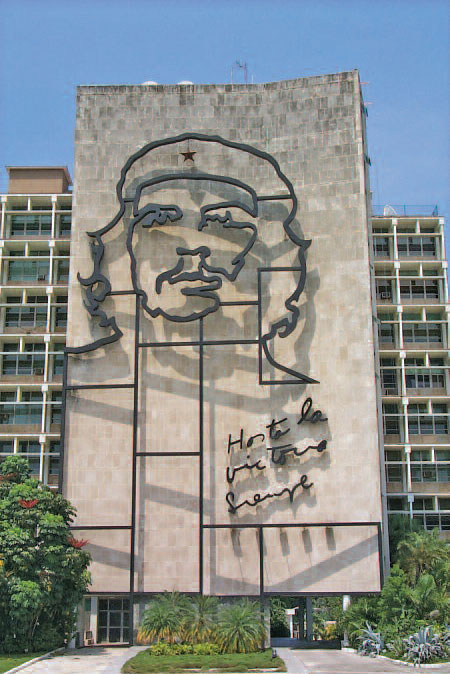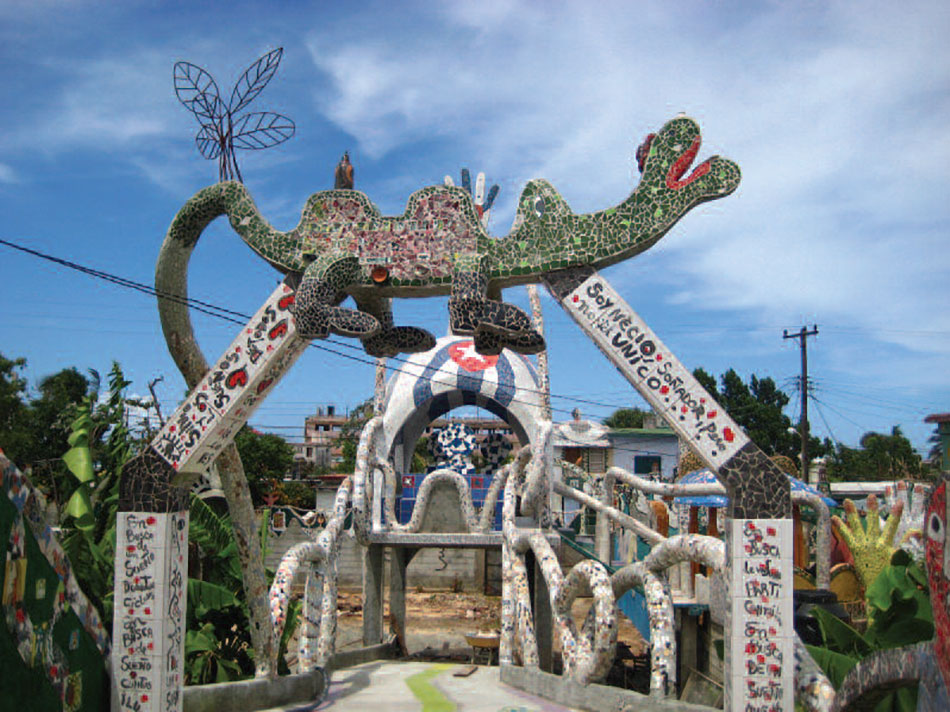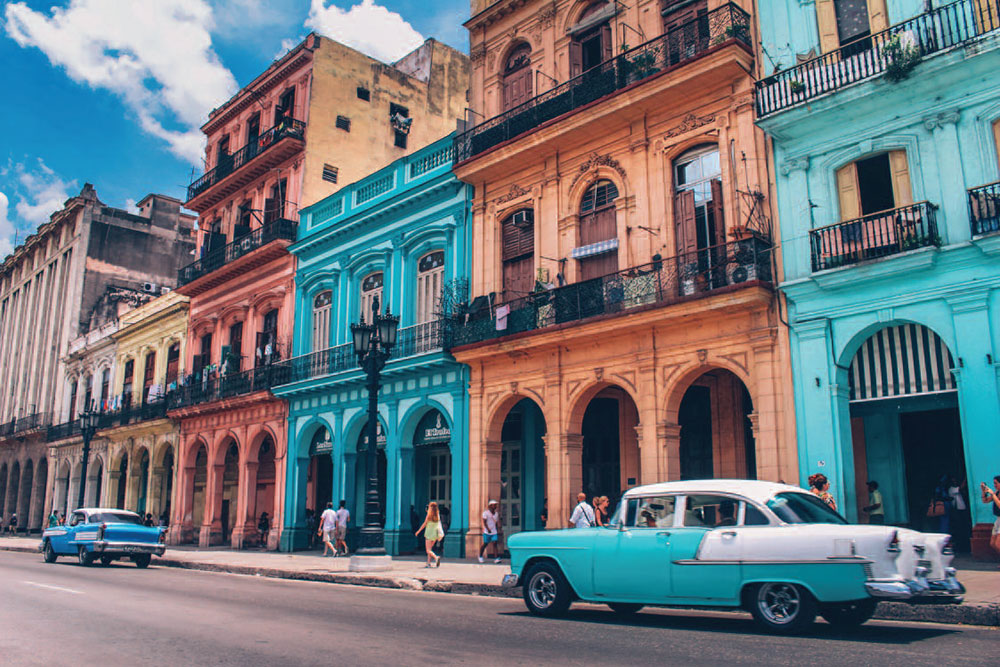
A tour of Havana leads to a priceless discovery
I stood on the upper deck of a cruise ship at dawn as it slowly drew into Havana Harbor. The buildings were low and dark compared to the high-rise dazzle of Miami, our point of departure. Cuba is only ninety miles from Key West, the port we set sail from the night before. But it looked as if we were traveling back in time. As a child of the Cold War, I had the sensation of gliding into a world that looked strangely preserved at it was when it was first closed to Americans in 1961.
Cuba still isn’t really open. Up until the day before, lawyers for the Royal Caribbean Cruise Line had negotiated with U.S. government officials about what we would be able to do and see, given recently tightened sanctions. And the limitations were not just political. We could spend cash only, convertible pesos or U.S. dollars, no credit cards because there is virtually no Internet. The Cuban government blames the crumbling telecommunications infrastructure on the United States trade embargo in place since the 1960s. Dissidents blame government censorship. A professor on the ship explained that if we happened to see a big cluster of people sitting together on the Malecon seawall that surrounds Havana, it would mean that someone had found a rare hotspot.
The morning air was soft and warm. Passengers stood along the rails watching and filming on phones. The quiet was a striking change from the usual party atmosphere on the upper pool deck, the music and entertainment, the endless towels and food and drinks dispensed by smiling attendants. Most of the early risers, including my sister and me, had already chosen a breakfast from a ridiculously lavish buffet. But out on deck there was a pause, as if people recognized that something quietly amazing seemed to be happening.
Only recently have American cruise ships been allowed to dock in Havana. According to ship officials, everyone aboard, even those from other countries, was an American tourist by virtue of traveling on the ship. And yet I wanted to be more than a tourist. I wasn’t coming as a pilgrim exactly, but I wanted to see. Seeing is more than looking, I knew. And it doesn’t happen often. It is an act of opening to receive impressions, and it requires that we see ourselves.
In the distance stood Morro Castle guarding the harbor, and the statue of Christ of Havana blessing it. Instead of arms outstretched like the famous Christ the Redeemer statue in Rio de Janeiro, this statue of Christ keeps his elbows close to his sides. The local joke is that he looks like he is holding a cigar in one hand and a mojito in the other. Rum drinks and cigars, streets full of interesting little shops, music and street performers, this is the brochure version of Havana.

“Welcome to Jamaica!” said the smiling young official waiting for us on the dock, as beautiful women serenaded us with guitars. His jest highlighted how different this Caribbean experience would be. After immigration, we boarded a bus provided by the government-approved Havana Tours, and drove through broad avenues and side streets and buildings that are visibly crumbling. The decay is due to many causes, among them the U.S. trade embargo and the collapse of the Soviet Union, which provided crucial subsidies. Yet on peeling walls everywhere is the famous image of Ernesto “Che” Guevara, the Argentinean-born hero of the Cuban Revolution, an icon of the counterculture and revolutionary idealism around the world.
We drove through a sea of colorful old cars. Our guide explained that the bright and shiny ones were actually rebuilt inside with new Japanese parts and reserved for tourists. The genuinely old ones belched exhaust and broke down frequently. Still, locals depended on these taxis because the trains run so slowly. It was moving and chastening to see Che so often. I saw how I had filed away the image, relegating it to the past, a rebellious dorm-room decoration, a doomed phase. But here it was very much alive, a source of patriotism and pride.
And our young guide was proud, pointing out what was less visible. “There is no problem with racism in Cuba,” she said. “Everyone is mixed.” Dimly, I remembered hearing that when Fidel Castro visited New York, he chose to stay in Harlem. No one has running water all day long, but medical care is universal and excellent, and so is education. Everyone makes almost the same salary in a command economy, and many people supplement their incomes (tour guides often are professors too). But there is no abject poverty. We saw no homeless people all day.
The bus stopped in Revolution Square, once the scene of vast political rallies led by Castro denouncing American imperialism. On this day it was just a vast and empty space with tourists debarking from buses, bordered by colorless government office buildings. The space is dominated by a huge monument—not to Castro, whose dying wish was no monuments in his honor—but to José Martí, a poet, journalist, and hero to Cubans of all political views because of his passionate commitment to sovereignty, individual as well as national.
Martí, who died in 1895 fighting the Spanish for Cuban independence, had lived in New York, in the heart of what he called the “monster,” as I did. He loved aspects of his life there. He championed personal expression, but he said that the United States “in its excessive worship of wealth, has fallen, without any of the restraints of tradition, into the inequality, injustice and violence of the monarchies.”
On the façade of a ministry building opposite the Martí memorial is the famous visage of Che Guevara, cast in steel and gigantic, underscored by the quotation Hasta la victoria siempre, which means “to victory always,” Che’s parting line to the Cuban people before he went off to foment revolution in the Congo and later in Bolivia, where he was executed by CIA-assisted forces. Right here, taking my turn among crowds of tourists, I posed for a picture with my sister, followed by several selfies.
Of course it was a touristy act, and I saw myself doing it. At one and the same time, I saw an American tourist, full of the limiting beliefs and assumptions and habits that came from my conditioning, and also that I was more than this, capable of opening to an awareness that could see for brief moments without judgment, and be touched.
Everything and everyone is in movement. Nothing and no one is permanent. I looked up at the vast office buildings, the Cuban Revolution now frozen into a giant bureaucratic state. According to the professor who spoke to us on the ship, most Cubans, most of the workers I was looking up at, subscribe to El Paquete, “The Weekly Package,” a digital drive of movies, news, instructional videos, ads, and Spanish and English television shows (including Game of Thrones and Keeping up with the Kardashians) that is delivered to their homes. Just like us, they yearn to connect.
We were driven to the Christopher Columbus Cemetery (Columbus is credited with discovering Cuba in 1492), where we visited the grave of La Milagrosa. “The Miraculous One” is Cuba’s unofficial saint, a lovely young woman who died in childbirth in 1901, and was buried with her stillborn son near her feet. According to legend her tomb was opened in 1914, and she was found to be uncorrupted, a sign of sanctity in both the Roman Catholic and the Eastern Orthodox Church. She was cradling her baby in her arms.
“To me this is a creepy story,” said a woman standing next to me. “It suggests that she was buried alive.”
And yet for more than a hundred years people have come to this tomb to pray and make wishes because La Milagrosa represents the power of love, and the possibility incorruptibility, of keeping it all together no matter what. Our guide encouraged us to enact a ritual that was performed by the young woman’s husband when he visited the tomb.
He always rapped one of four brass rings on the tomb, announcing his presence to his wife. He stood before the statue of mother and child, communing, expressing his thoughts, and describing the events of any particular day, always leaving the tomb walking backwards, never turning his back on his beloved. Our guide encouraged us to take turns doing the same. The woman standing beside me stepped back, but I did it and so did my sister.
Here again, I glimpsed the double pull inside. We want to be safe, to come to a state of indestructible unity. But another part of us—that awareness that sometimes appears and sees—senses that our real freedom inevitably involves letting go and loss. “Cut a chrysalis open,” writes Rebecca Solnit, “and you will find a rotting caterpillar.”
Our lives move from hope to hope, and at bottom all hope is hope for change. And under it all we all long for freedom. From selfish to selfless, from petty to profound, with more or less awareness and compassion, we seek freedom from suffering and from separation. We seek ways to be more vibrantly alive, to be with life. Our greatest fear is breaking down, and our greatest hope is breaking open.

Seeing is a way of opening. I glimpsed this in Fusterlandia. Over a period of thirty years, Jose Rodriguez Fuster, a Cuban naïve artist, turned Jaimanitas, a tiny, fishing town on the outskirts of Havana, into a work of eccentric, beautiful mosaic art. Bit by bit, starting with his own small wooden house, Fuster has transformed some eight houses and shops into a place of surprise and possibility. Fuster had traveled to Europe and seen the work of Gaudi in Barcelona, and Brancusi in Romania. His work isn’t original so much as an individual affirmation that it is possible to re-envision and transform our lives anywhere and any time, using the materials at hand.
The walls and roofs and arches are decorated with mermaids, fish, roosters, and Santeria saints (here and there in the streets of Havana, we see young women dressed all in white, initiates in what our guide called a “nature religion”). Fusterlandia includes a park with giant chess pieces, a shrine to Princess Diana, and a mural showing Fidel and Raul Castro and Che Guevara aboard the Granma yacht, sailing from exile in Mexico to bring revolution.
Havana harbors many unexpected twists, including a park dedicated not to Vladimir Lenin but to John Lennon. In 2000, as “All You Need is Love” played, Castro unveiled a bronze statue that captures Lennon in his long-hair, anti-war activist days (his wire-rimmed glasses have been stolen so often a guard is posted on duty, poised to place the glasses on the statue when visitors appear). Although he initially banned the Beatles’ music, Castro came to praise Lennon’s thinking and dedication to the working class.
“I share his dreams completely,” said Castro at the unveiling. “I too am a dreamer who has seen his dreams turn into reality.”
Yet it is Fusterlandia that offers the clearest evidence that, as Fuster has said, “all dreams get realized over time.” Just begin, his works instructs. Start where you are. See what you have. Be open to the possibilities. I walked around Fusterlandia, registering that a revolution can happen in a moment, in an action smaller than the placing of one tiny ceramic tile. We can shift from being confined by our limiting thoughts to being in the present moment. We can open to a new life. ♦
From Parabola Volume 43, No. 1, “Wealth,” Spring 2018. This issue is available to purchase here. If you have enjoyed this piece, consider subscribing.
